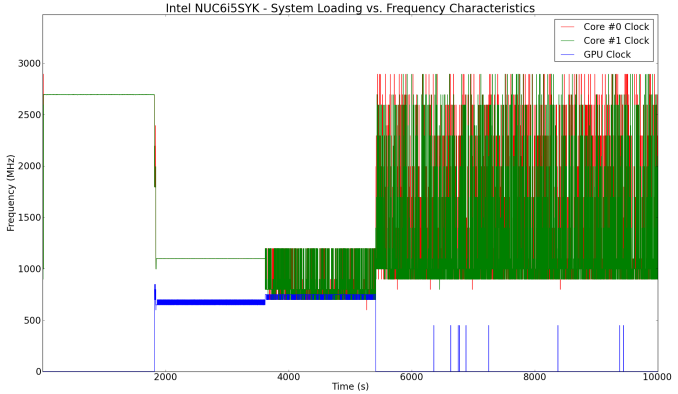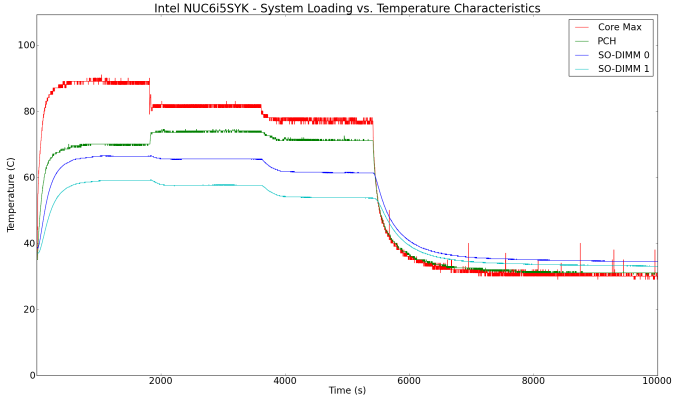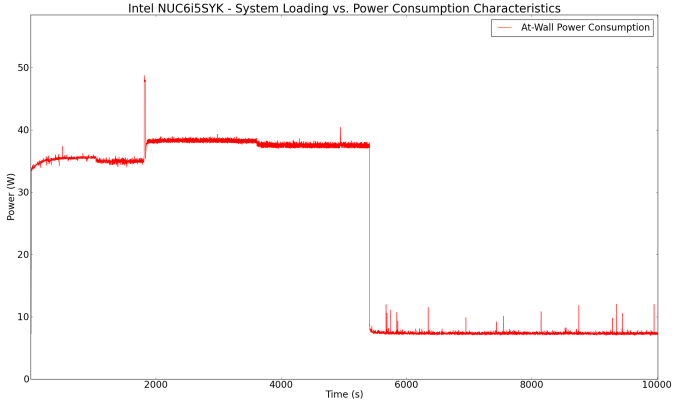The Intel NUC6i5SYK Skylake UCFF PC Review
by Ganesh T S on March 11, 2016 8:00 AM ESTPower Consumption and Thermal Performance
The power consumption of the NUC6i5SYK at the wall was measured with a 1080p display being driven through the HDMI port. In the graphs below, we compare the idle and load power of the Intel NUC6i5SYK with other low power PCs evaluated before. For load power consumption, we ran Furmark 1.12.0 and Prime95 v27.9 together. While the idle power number is consistent with a system sporting a 15W TDP processor, the load power is quite high at 38.37W (considering that the Haswell-based NUCs idled a full 10W lower while also using a 15W TDP processor).


Analyzing the AIDA64 system report and the default BIOS configuration revealed that the unit was optimized for maximum performance. The long duration CPU power limit was set to 23W for a time duration window of 96s and the short duration CPU power limit was set to 30W for 2.44ms. For comparison, the Core i7-6600U in the Surface Book has a long duration CPU limit of 15W for 28s and a short duration limit of 25W for 2.44ms. As we shall see further down in this section, the Core i5-6260U in the NUC6i5SYK doesn't pull back significantly from the 23W limit even under sustained load (despite the 96s configuration).
Moving on to our thermal stress routine, we started with the system at idle, followed by 30 minutes of pure CPU loading. This was followed by another 30 minutes of both CPU and GPU being loaded simultaneously. After this, the CPU load was removed, and the GPU was loaded alone for another 30 minutes. The various clocks in the system as well as the temperatures within the unit are presented below.
We find that the cores spend very little time at the turbo speed of 2.9 GHz, but the steady clock rate is around 2.6 GHz throughout the duration when the CPU was completely loaded. The Core i5-6260U is advertised with a base clock of only 1.8 GHz. There is no throttling at play here even under full CPU load. However, when the GPU gets loaded , the cores drop down to around 1.1 GHz even under load. As we shall see further down, this is probably limited by package power. The GPU cores have a base frequency of 300 MHz (turbo to 950 MHz). Under load, we see it operate between 600 - 700 MHz depending on whether the CPU is loaded simultaneously or not.
According to the official specifications, the junction temperature of the Core i5-6260U is 100C. The thermal solution is more than good enough to maintain the temperature below 90C even under extreme stress. The cores also idle around 33C.
In addition to the frequencies and temperature, we also tracked the power consumption at the wall during the thermal stress testing process. Here, we find that the performance of the system is actually limited by the maximum sustained power consumption limit (around 38W under the tested load conditions) for the system. Irrespective of the CPU and GPU loading, the power consumption is kept under these limits (except for the short spike close to 48W corresponding to the Short Duration Power Limit reported by CPUID).
Since the NUC6i5SYK is not a passively cooled PC, we decided to skip our usual thermal photographs. Given the observed internal temperatures during thermal stress testing and the thermal design (case with adequate number of vents, a blower solution and a plastic lid), we believe that the external case temperatures will not be a cause for concern even under heavy system load.













95 Comments
View All Comments
Teknobug - Sunday, March 13, 2016 - link
"for external graphics"^ did you miss that?
AnnonymousCoward - Monday, March 14, 2016 - link
I read "external graphics" as a monitor. Now I guess he meant a GPU. So who exactly would want to match a 15W CPU with a discrete GPU?TheinsanegamerN - Monday, March 14, 2016 - link
Given the sales of the alienware 13, my guess would be more then you think. Most games dont need a quad core i7 to run properly.AnnonymousCoward - Monday, March 14, 2016 - link
It's true that games can run ok, but still. This cpu would likely be a big bottleneck in loading, and processing all the elements of a big game that has hundreds or thousands of moving things. VR will want more cpu. But sure, if you just wanna run CS, you can use any cpu.TheinsanegamerN - Wednesday, March 16, 2016 - link
The AW13 cn oush games like shadow of mordor with an external dock. Slower, yes, but it can still hit 50fps+.Of course, nobody who wants maximum settings would buy the NUC, but more midrange gamers would be served well. And since the skull canyon will most likely be a quad core part, CPU performance will be a moot argument,
zodiacfml - Saturday, March 12, 2016 - link
The CPU power limits are quite impressive compared to my i5-5200u. this makes its performance not far from the ECS LIVA One.Sivar - Saturday, March 12, 2016 - link
Thank you for the article.I am a little disappointed with vendors that fanless NUCs are still unavailable except as specialty parts with low-volumeish markups like Logic Supply (which makes great stuff, but not cheap).
HTPC Credentials typo: "Refresh Rate Accura[n]cy"
Zingam - Sunday, March 13, 2016 - link
$675 - and this includes the price of Win10 too?ganeshts - Sunday, March 13, 2016 - link
The configuration posted (256GB NVMe drive + Corsair 2400 MHz SODIMMs) doesn't include WIn 10 cost. However, I see now that 2133 MHz SODIMMs are available for a much lower price and, even the NVMe drive can be replaced by a much cheaper AHCI drive (IIRC, Mushkin's 256GB M.2 AHCI drive is only $85 or so - less than half the price of the NVMe Samsung drive).So, yes, it is possible to build the whole configuration along with Windows 10 for $675 (even lower is possible).
In our cost comparison tables as well as spec tables, we have never considered OS cost. So, the number quoted is consistent with our previous reviews.
twotwotwo - Monday, March 14, 2016 - link
If you go with 2x4GB DDR4, i3, and 256GB 850 EVO m.2 SSD, it's $400 (and, for the moment, there's Prime shipping on all that from Amazon). You can also opt for the taller one with the 2.5" drive slot to do the small SSD+big HDD thing. All to say, there are lots of compromises for cost short of, like, going to an older gen, a much larger box, or Atom.